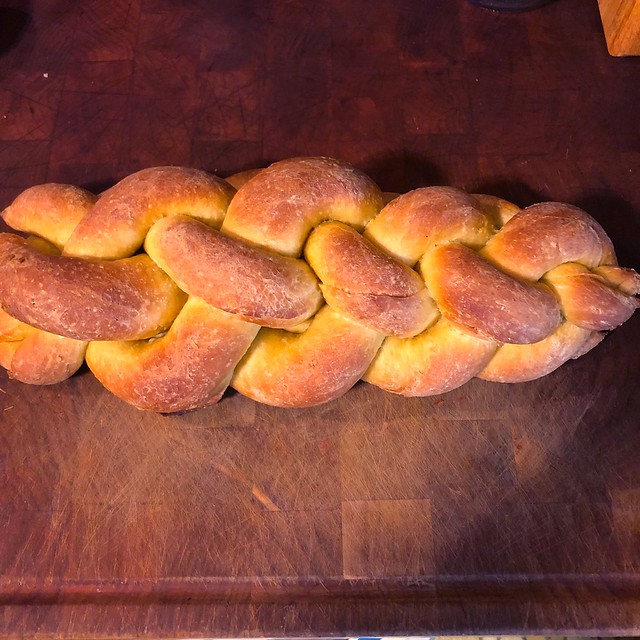Saturday, October 07, 2023
Recipe Round Up: Challah Bread and Crème Brûlée French Toast

Dough:
2 teaspoons yeast
2 cups pastry flour
1 1/2 cups bread flour, more as needed
1/4 cup warm water
3 large eggs
1/4 cup olive oil
1/4 cup honey
1 1/2 teaspoons table salt
Glaze and Topping:
1 egg, lightly beaten
sesame or poppy seeds (optional)
In a large bowl, mix the 1 teaspoon yeast with 1/2 cup of the flour. Add the warm water, stir, and let this mixture, the sponge, sit until it starts to puff up, 15-to 20-minutes.
Add the eggs, oil, honey, and salt; stir until well combined. The sponge will remain lumpy, this is normal. Add the remaining flour and yeast and mix the dough in the bowl until all the ingredients are combined. Turn the dough out onto a work surface and knead until fairly smooth, about 2 - 5 minutes. The dough should feel very firm and will be hard to knead. If it’s soft and sticky, add small amounts of flour until it’s very firm.
Transfer the dough to a large, clean bowl and cover it well. Let it rise until doubled in bulk and very soft to the touch, 2 hours or more, depending on the room temperature. Line a baking sheet with parchment or oiled foil. Stack this sheet over a second sheet (to keep the bottom of the bread from overbrowning during baking).
Shape the dough:
Turn the dough out onto a very lightly floured work surface and sprinkle a tiny bit more flour over it. Spread and flatten the dough a bit. Cut it into six equal pieces. Set aside the dough pieces, cover them lightly with plastic, and brush all the flour off the work surface. Have a small bowl of water handy. Using no flour, roll a piece of dough with a rolling pin into a very thin sheet, between 1/8 and 1/4 inch thick (don’t worry about making a rectangle; an amoeba shape is fine). The dough may stick to the work surface; this is alright, just nudge it gently with a dough scraper. Tightly roll up the sheet like a carpet to form a strand. Roll the strand back and forth between your hands until it’s thin, very even, and 12 to 15 inches long. At the ends of the strand, angle the outer edge of your hands into the work surface as you’re rolling to make the ends pointy and the strand thicker in the middle (this will help you get a mounded loaf). The strand needs to grip the work surface slightly during this rolling; the grab will help as you roll. If the strand is too slick, very lightly dampen it with water to help it grip the work surface better. Repeat the rolling out, rolling up, and elongating steps with the remaining five pieces of dough, rolling them out to the same length.
Arrange the strands parallel to one another. At one end, gather and pinch the strands very tightly together. Braid closely, following the insructions below (I will add photos later). Lightly tap each end of the loaf with your palms to tuck it under the loaf.
1. Move the second-to-the-right strand to the far-left position.

This doesn't look like it was the second to the right, because I just lightly pinched the ends, so it just kind of moved entirely.

3. Move the new second-to-the-left strand over to the far right position.

4. Move the far-left strand (the same strand you moved in step 1) over two strands to the center position. Now repeat the steps.

Transfer the braid to the lined baking sheet and cover it loosely but thoroughly with plastic wrap. Let proof until doubled in bulk and the loaf remains indented when lightly pressed, 2 hours or more, depending on room temperature. It is better to let the dough proof more rather than less.

Position an oven rack in the lower third of the oven and heat the oven to 325° F. Just before baking, brush the dough with the beaten egg. Sprinkle with sesame seeds or poppy seeds, if using. With a thin wooden skewer, poke the bread deeply all over (the holes will prevent air pockets and help the bread keep its shape during baking). Bake for 20 minutes. Rotate the challah 180 degrees and bake until the bread is a dark, burnished brown, about another 15 minutes. If the challah is browning too rapidly cover it loosely with foil and let it finish baking. Don’t remove the loaf too soon, as you’ll risk underbaking. Let cool thoroughly on a rack.
You probably won't have any left, but if there is any left over, save it for breakfast: day-old challah makes fantastic French toast.
Crème Brûlée French Toast I found a similar recipe to this on the internet, but one, I misread an ingredient and made it a little differently, and it turned out super well so I make it that way on purpose now, and two, it was written in a bizarrely vulgar and gross way, especially for a recipe. It was super juvenile, and a little ridiculous. So much so, I am not even referencing the original. Anyway, here is how I make it, and it is delicious. It can be made the night before, and brought out to bake while you shower, which means that even though it's kind of a special breakfast, it is also easy for a week day.
1/4 cup creamy peanut butter
1/4 cup butter
1 cup brown sugar, packed tightly
2 tablespoons maple syrup or honey
1 loaf of challah bread
5 large eggs
1/2 cup heavy cream
1 cup half and half
1 teaspoon vanilla
1 teaspoon Grand Marnier (or Kahlua or other liqueur)
1/4 teaspoon salt
In a small saucepan, melt the peanut butter, butter, brown sugar, and maple syrup over low heat, and stir until it is quite smooth. Pour the caramel into a 13" x 9" x 2" baking dish, rocking the pan back and forth gently so that the sauce covers the entire bottom.
Using a big bread knife, cut 6 one-inch slices from the middle of the challah. Trim the crusts off, if you wish, and save for nibbling. Arrange the slices in a single layer in the baking dish, squeezing them in next to each other. They don't need space.
In a large bowl, whisk together the eggs, heavy cream, half and half, vanilla, Grand Marnier, and salt. Pour the custard concoction over the bread evenly. Wrap it with plastic, and put it in the fridge for at least 8 hours, max one day.
Set the oven to 350 degrees, and pull out the pan, bringing the bread mixture to room temperature. Bake uncovered for 30 to 35 minutes until puffy and golden around the edges. Eat it while it's still hot!
Labels: Homemaking, Recipes, Tales from the Kitchen


